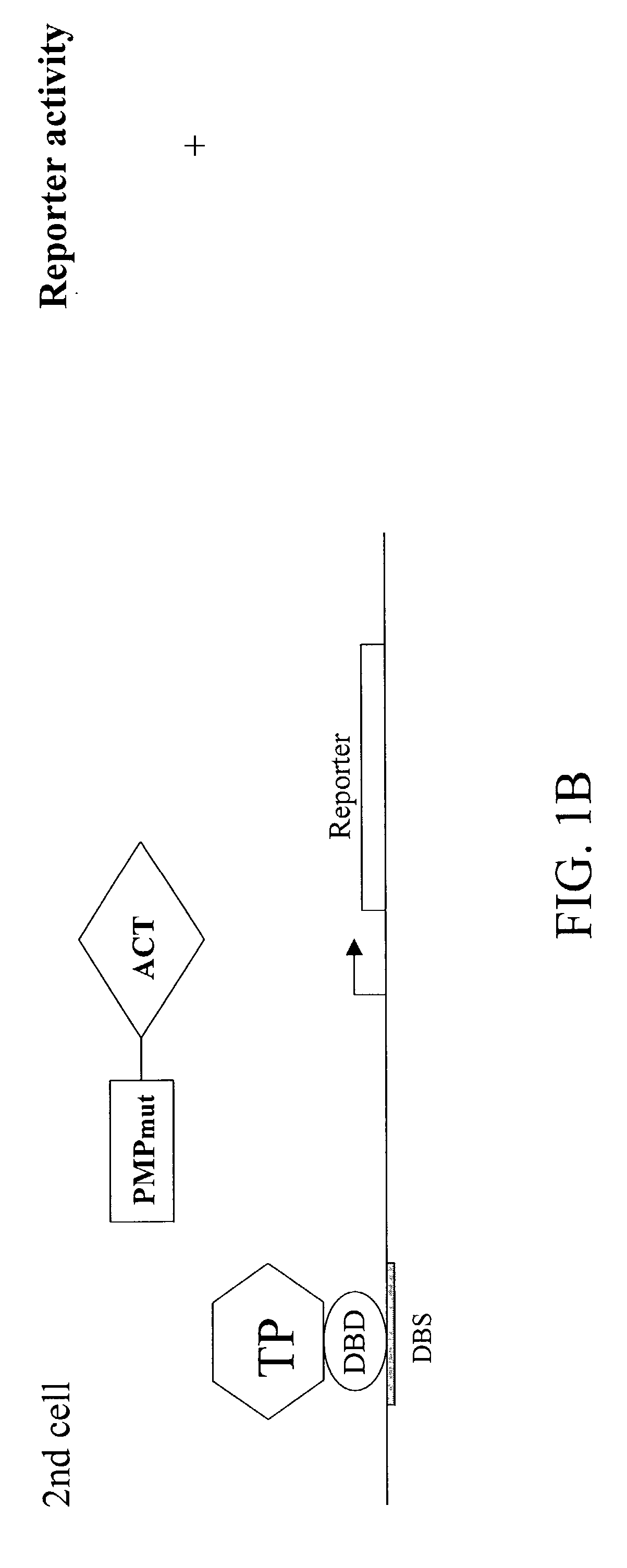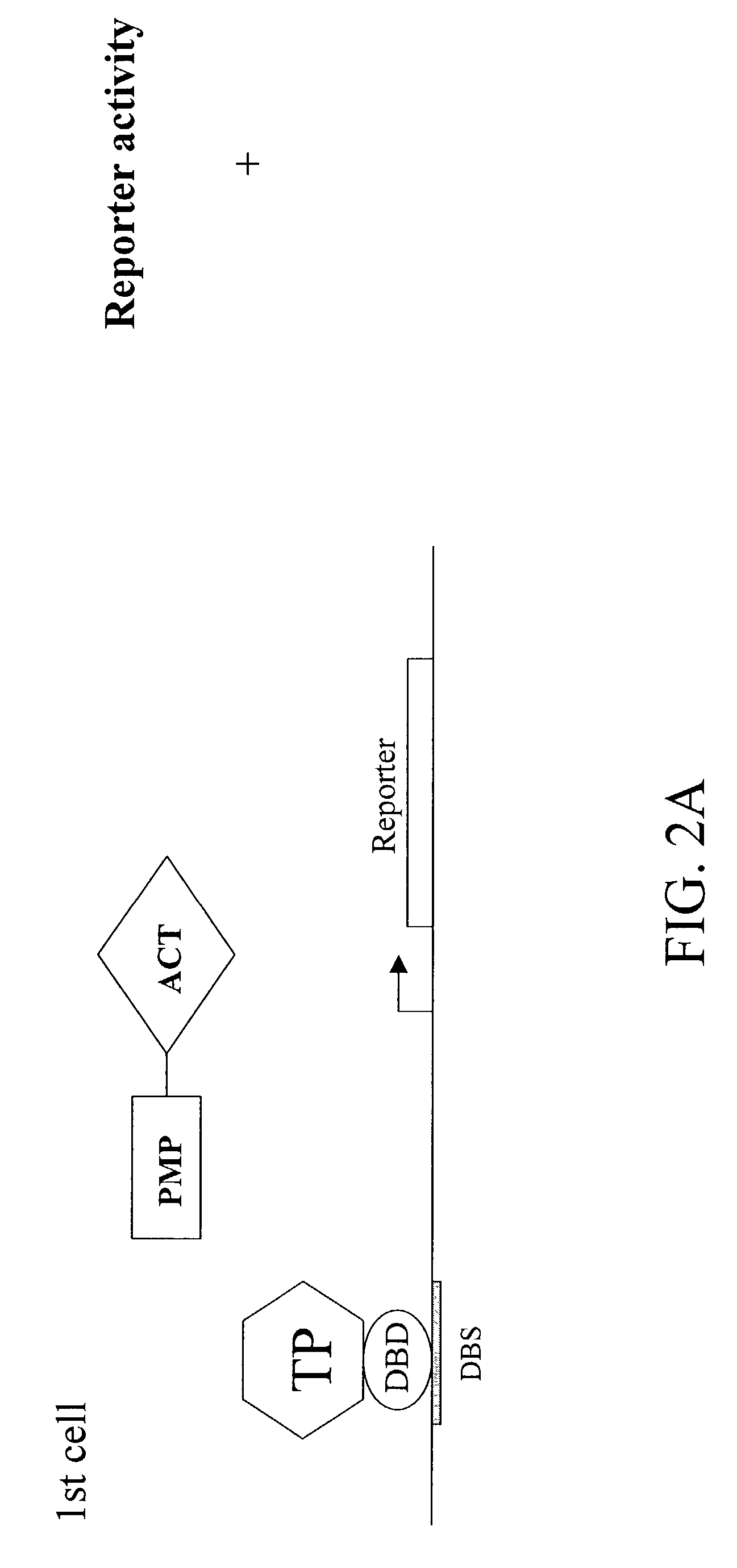Transcription-based assay for identification of post-translational modification and its application in proteomics
a transcription-based assay and post-translational modification technology, applied in the field of transcription-based assay for identification of post-translational modification and its application in proteomics, can solve the problems of inability to solve the lack of e3 activity, inability to specific trafficking and localization of target proteins, and general inefficiency of the vitro approach, so as to achieve simple and rapid assay, improve the effect of e3 activity and the ability to target specific proteins
- Summary
- Abstract
- Description
- Claims
- Application Information
AI Technical Summary
Benefits of technology
Problems solved by technology
Method used
Image
Examples
example 1
Modification of Gal4-p53CT WT by VP-SUMO WT
[0083]To demonstrate the present invention, p53, a known SUMO target protein, was examined. The C-terminal portion of p53 (“p53CT WT”) has been shown to be sufficient for sumolation, and contains a single SUMO-attachment site at K386. A single point mutation (K386R) that substitutes lysine 386 with arginine abolishes sumolation. Plasmids were constructed which express Gal4 fusions of the C-terminal portion of p53 (“Gal4-p53CT WT”) as well as its non-modifiable mutant version (“Gal4-p53CT K386R”). Also constructed were plasmids expressing VP16-SUMO WT and VP16-SUMO GA. SUMO GA is identical to SUMO WT, except for a single point mutation (Gly 97 to Ala) that abolishes it ability to covalently modify target proteins.
[0084]HeLa cells were transfected with the Gal4-reporter G5-tk-CAT plasmid, and a plasmid expressing Gal4-p53CT WT, a fusion protein containing the Gal4 DNA binding domain and the last 100 amino acid residues of p53. This region has...
example 2
Modification of Gal4-p53CT WT by VP-SUMO WT Examined in Another Cell Line
[0087]To illustrate that the present invention can be applied to different types of cells, experiments were carried out similar to the specific example described above, but in a different cell line, GH4C1. GH4C1 cells were transfected with the Gal4-reporter G5-tk-CAT plasmid, and a plasmid expressing Gal4-p53CT WT. When appropriate, a plasmid expressing VP16-SUMO WT or VP16-SUMO GA was cotransfected, as indicated in FIG. 10. CAT activity in the presence of VP16-SUMO GA was used to define 1-fold activation. As shown in FIG. 10, cotransfection of VP16-SUMO WT with Gal4-p53CT WT results in a significant further activation of the reporter (by about 10-fold) comparing to cotransfection of VP16-SUMO GA, suggesting the sumolation of p53CT WT in GH4C1 cells. To further document that the observed reporter activation by VP16-SUMO WT is due to sumolation of p53CT WT per se as opposed to other mechanisms, including a possi...
example 3
Modification of Gal4-p53FL WT by VP-SUMO WT
[0088]The two examples shown above involve using p53CT WT as the test target protein for sumolation. It was found that Gal4-p53CT WT itself mediates little, if any, transcriptional activation in cells, which is an ideal trait for a candidate target protein that is to be examined. To illustrate that the present invention can also be applied to examine a candidate target protein that is itself transcriptionally active, experiments were performed with a full length wild-type p53 (p53FL WT). The full length wild-type p53 (p53FL WT) has also been shown to be a substrate for sumolation, and contains a single SUMO-attachment site at K386. A single point mutation (K386R) that substitutes lysine 386 with arginine abolishes sumolation. Plasmids were constructed which express Gal4 fusions of the full length wild-type p53 (Gal4-p53FL WT) as well as its non-modifiable mutant version (Gal4-p53FL K386R). HeLa cells were transfected with the Gal4-reporter ...
PUM
| Property | Measurement | Unit |
|---|---|---|
| fluorescent | aaaaa | aaaaa |
| stability | aaaaa | aaaaa |
| chemical/molecular groups | aaaaa | aaaaa |
Abstract
Description
Claims
Application Information
 Login to View More
Login to View More - R&D
- Intellectual Property
- Life Sciences
- Materials
- Tech Scout
- Unparalleled Data Quality
- Higher Quality Content
- 60% Fewer Hallucinations
Browse by: Latest US Patents, China's latest patents, Technical Efficacy Thesaurus, Application Domain, Technology Topic, Popular Technical Reports.
© 2025 PatSnap. All rights reserved.Legal|Privacy policy|Modern Slavery Act Transparency Statement|Sitemap|About US| Contact US: help@patsnap.com



